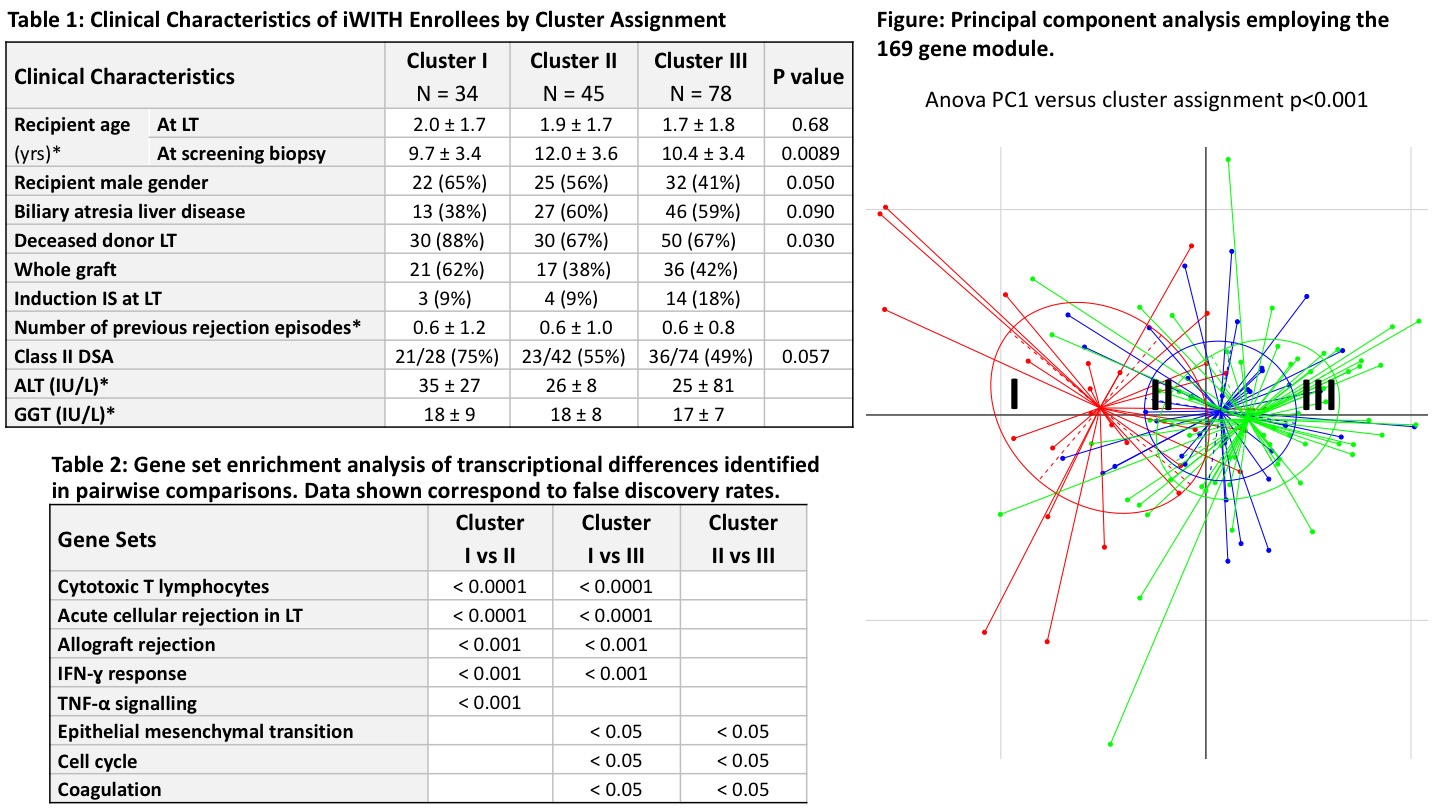Tissue Transcriptional Profile of Portal Inflammation with Interface Activity in Pediatric Liver Transplant (LT) Recipients with Normal Liver Tests Closely Resembles T Cell Mediated Rejection (TCMR).
KCL, London, United Kingdom
UCSF, SF
Pittsburgh, Pittsburgh
Cincinnati, Cincinnati
CiberEHD, Barcelona, Spain
Michigan, Ann Arbor
Rho, Chapel Hill
ITN, Bethesda
NIDDK/NIAID/NIH, Bethesda
Meeting: 2017 American Transplant Congress
Abstract number: 558
Keywords: Fibrosis, Inflammation, Liver transplantation, Multicenter studies
Session Information
Session Time: 8:00am-10:00am
 Presentation Time: 8:00am-8:15am
Presentation Time: 8:00am-8:15am
Location: Arie Crown Theater
Background: Significant inflammation±fibrosis is frequently seen in biopsies (bxs) of pediatric LT recipients with normal liver tests assessed for immunosuppression withdrawal. The pathogenesis of these subclinical lesions is unknown.
Methods: Bxs (central pathologist) from children meeting clinical and ALT/GGT eligibility criteria (iWITH; NCT01638559) sorted into 3 clusters: I) portal inflammation+interface activity; II) fibrosis w/o inflammation; III) minimal/no findings. Liver tissue RNA was hybridized onto U219 whole-genome Affymetrix arrays. We identified modules of co-regulated genes significantly associated with clinical, serological [α-Class II donor specific antibodies (DSAs)] and histological factors and used functional pathway analysis to explore enrichment in pathways associated with allograft injury. Pairwise comparisons assessed for cluster-based transcriptional differences.
Results: 157 subjects with ALT/GGT of 28±17/19±19U/L (Table 1) had bxs. One module of 169 genes significantly correlated with portal inflammation, interface activity, fibrosis and DSA (Fig). The module was enriched in gene sets previously associated with TCMR with IFN-[Upsilon] as the main upstream regulator. Pairwise comparisons showed that rejection-associated gene sets were over-represented in Cluster I vs II and III. Cluster II and III differed only in fibrogenesis genes (Table 2).
Conclusions: Detailed analyses of bxs from pediatric LT recipients with normal liver tests identified distinct patterns of allograft damage. Subclinical inflammation is associated with Class II DSA and shows a transcriptional profile closely resembling that of TCMR. In contrast, molecular evidence of TCMR was NOT observed in the absence of inflammation even with fibrosis ± Class II DSA. 
CITATION INFORMATION: Sanchez-Fueyo A, Feng S, Demetris A, Bucuvalas J, Lozano J, Magee J, Spain K, Kanaparthi S, iWITH Investigators Tissue Transcriptional Profile of Portal Inflammation with Interface Activity in Pediatric Liver Transplant (LT) Recipients with Normal Liver Tests Closely Resembles T Cell Mediated Rejection (TCMR). Am J Transplant. 2017;17 (suppl 3).
To cite this abstract in AMA style:
Sanchez-Fueyo A, Feng S, Demetris A, Bucuvalas J, Lozano J, Magee J, Spain K, Kanaparthi S, Investigators iWITH. Tissue Transcriptional Profile of Portal Inflammation with Interface Activity in Pediatric Liver Transplant (LT) Recipients with Normal Liver Tests Closely Resembles T Cell Mediated Rejection (TCMR). [abstract]. Am J Transplant. 2017; 17 (suppl 3). https://atcmeetingabstracts.com/abstract/tissue-transcriptional-profile-of-portal-inflammation-with-interface-activity-in-pediatric-liver-transplant-lt-recipients-with-normal-liver-tests-closely-resembles-t-cell-mediated-rejection-tcmr/. Accessed December 31, 2025.« Back to 2017 American Transplant Congress
